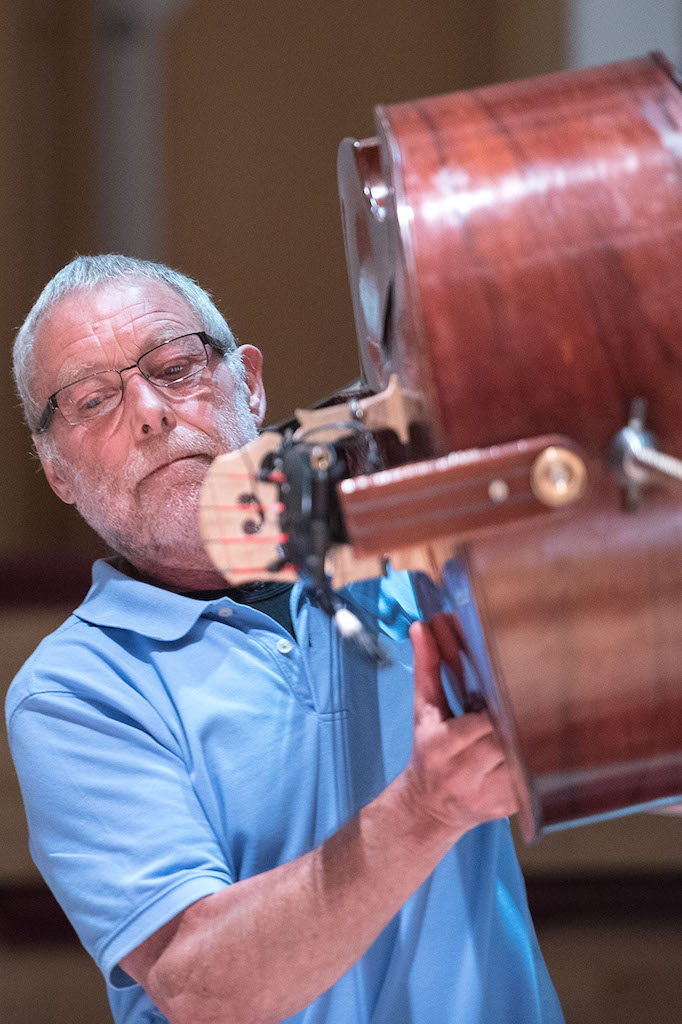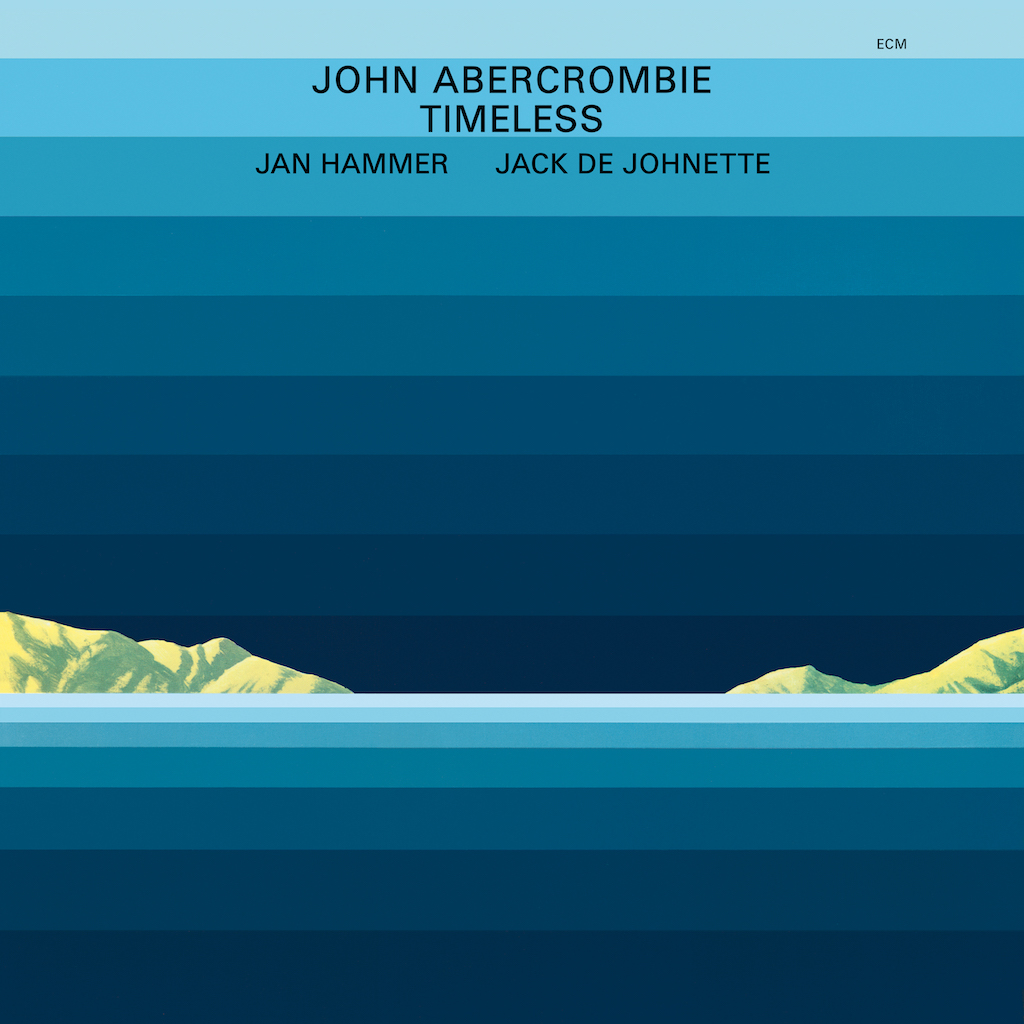
Reviewing Maria Farantouri’s and Cihan Turkoglu’s Beyond The Borders (2017) this October, John Adcock spoke of “the broad church of the ECM catalogue”. Some may fret that such a breadth of conception risks diluting whatever jazz may remain in the pan-cultural mix. But that would be to misread entirely the DNA of ECM.
Hear, for example, the snapping, nudging ‘n’ burning title track of Prime Directive (1998) by the Dave Holland Quintet – and ask yourself, how much more full-on jazz could you wish for? Or relish the fluid, flowing momentum which, in common with his work with Jan Garbarek and Shaukat Hussain on Madar (1992), distinguishes Tunisian oud virtuoso Anouar Brahem’s Thimar (1997) with John Surman and Dave Holland and Blue Maqams (2017) with Django Bates, Holland and Jack DeJohnette.
Each of these three latter albums is as striking a modally turned example as one could wish of the culture-bridging, simultaneously intense and expansive manner in which Manfred Eicher and ECM have encouraged jazz and improvised music to flourish, amplifying the import of the music in any number of ways.
Compare, for example, the tough modal blues of Mal Waldron’s Free At Last with the Zen-funk grooves of Nik Bärtsch’s Ronin on albums like Stoa (2005), Live (2011) and Awase (2017). There is an illustrative moment in the Sounds And Silence film when Eicher pays acute attention to the most subtle resonance of piano overtones at a particular moment in a Ronin session, with Bärtsch paying scrupulous regard. As Eicher emphasised in that May 2017 Jazz Magazine interview, none of this has involved any inflexible preconception on his part: “I’ve understood that it’s necessary always to adapt oneself to the proposal or perspective which a musician might have – and not to come to projects with any rigid or pre-established conceptions […] And I’m not engaged in any systematic search for new artists; I love discovering musicians by chance, perhaps through travel or an unexpected encounter”.
One finds at ECM, therefore, no mannered dilution of the spirit of jazz, as unsympathetic critics have on occasion claimed. On the contrary: there is at ECM a vast range of organically wrought music which remains as fresh as tomorrow while evincing the most literate awareness of the jazz tradition, including its African roots and the backbone of the blues. In many respects, Italian trumpeter Enrico Rava exemplifies this creative dialectic.
An associate of Gato Barbieri, Steve Lacy and Roswell Rudd in the mid-to-late 1960s and early 1970s, and steeped in both bebop and free jazz, Rava – who has worked with distinguished visual artists such as Michelangelo Pistoletto – found his natural home at ECM. Hear his lyrical debut for the label, The Pilgrim And The Stars (1975) with John Abercrombie, Palle Danielsson and Jon Christensen, or later and equal triumphs such as Easy Living (2003), The Words And The Days (2005) and New York Days (2008) – the last featuring Paul Motian, whose early work as a leader for ECM is documented in the six-CD Old & New Masters box set Paul Motian (1972/74/77/79/81/84). Listening to the kicking rhythm and sheer melodic joy of Rava’s fast-moving, 14-track Wild Dance (2015) with a.o. trombonist Gianluca Petrella, I can’t help but think that if the Louis Armstrong of the fabled Hot Five and Seven sessions were here today, he would love it.
Sample, in addition, albums as similarly soaked in archetypal qualities as Paul Bley’s Open, To Love (1972) and Play Blue (2008); Dave Holland’s Conference Of The Birds (1972) with Anthony Braxton, Sam Rivers and Barry Altschul; Witchi-Tai-To by the Jan Garbarek-Bobo Stenson Quartet (1973); Kenny Wheeler’s Gnu High (1975) with a.o Keith Jarrett; Gateway (1975) by John Abercrombie, Dave Holland and Jack DeJohnette; the Keith Jarrett Quartet’s Eyes Of The Heart (1976) with Dewey Redman, Charlie Haden and Paul Motian; the box-set John Abercrombie: The First Quartet (1978/79/80) with Richie Beirach, George Mraz and Peter Donald; George Adams’s Sound Suggestions (1979) with a.o. Beirach and Kenny Wheeler; Jack DeJohnette’s box-set Special Edition (1979/80/82/84) with a.o. David Murray, Arthur Blythe and Chico Freeman; Chick Corea’s Trio Music (1981) with Miroslav Vitous and Roy Haynes; Bengt Berger’s Bitter Funeral Beer (1981) with a.o. Don Cherry; John Abercrombie’s Night (1984) with a.o. Michael Brecker and Jan Hammer; Dave Holland’s Seeds Of Time (1984) with a.o. Steve Coleman, Julian Priester and Marvin “Smitty” Smith; Charles Lloyd’s box-set Quartets (1989/91/93/94/96) with a.o Bobo Stenson, Anders Jormin and Billy Hart; Kenny Wheeler’s Music For Large & Small Ensembles (1990) with a.o. John Taylor, Norma Winstone, Stan Sulzmann, Paul Rutherford and Peter Erskine; Wadada Leo Smith’s Kulture Jazz (1992); John Surman’s and John Warren’s The Brass Project (1992) with a.o. John Marshall; Keith Jarrett’s At The Blue Note: The Complete Recordings (1994) with Gary Peacock and Jack DeJohnette; the Tomasz Stanko Septet’s Litania: Music Of Krzysztof Komeda (1997); Bobo Stenson’s Serenity (1999) with Anders Jormin and Jon Christensen; Charles Lloyd’s Which Way Is East (2001) with Billy Higgins; Manu Katché’s Neighbourhood (2004) with a.o. Jan Garbarek and Tomasz Stanko; Arild Andersen’s Live At Bellville (2007) with Tommy Smith and Paolo Vinaccia; Andy Sheppard’s Movements In Colour (2008) with a.o. John Parricelli and Arild Andersen; the Steve Kuhn Trio’s Mostly Coltrane (2008) with Joe Lovano; Miroslav Vitous’s Remembering Weather Report (2006-7) with a.o. Michel Portal, and Music Of Weather Report (2010-11); Paul Motian’s Lost In A Dream (2009) with Chris Potter and Jason Moran ; Jack DeJohnette’s In Movement (2015) with Ravi Coltrane and Matthew Garrison; Chris Potter’s The Dreamer Is The Dream (2016) with a.o. David Virelles; Ethan Iverson’s Common Practice (2017) with a.o. Tom Harrell and the Louis Sclavis Quartet’s Characters On A Wall (2018).
There is no ‘easy children’s music’ here: rather, a cornucopia of blues-shot, melodically and rhythmically vibrant jazz, both modal and harmonic in nature, and all of the highest order
There is no “easy children’s music” here: rather, a cornucopia of blues-shot, melodically and rhythmically vibrant jazz, both modal and harmonic in nature, and all of the highest order. But as the shape-shifting vivacity of these ECM projects shows, the label consistently resists any sort of calcified approach, keeping the creative impulse alive and open. It was not for nothing that the 2002 Lars Müller monograph on the Swiss artist Mayo Bucher, whose work appears on a good many ECM covers, was titled Open Sign – or that Arno Oehri’s and Oliver Primus’s 2018 film for ECM about the late John Abercrombie was called Open Land.

At ECM, it is not so much a matter of “It don’t mean a thing, if it ain’t got that swing” as – why should music always swing, and what might it mean to “make it swing” in a fresh, different and distinctive way? To instance but two of many possible examples: hear the drone-fed, raga-touched melodic magic of the title track of Abercrombie’s Timeless (1974) with Jan Hammer and Jack DeJohnette, or the delicious blend – as stimulating as it is satisfying – of radically fresh dynamics and melodic sonorities, of rhythmic repose and urgency, in the 2011 Equilibrium trio date led by German pianist Benedikt Jahnel.
With Spanish bassist Antonio Miguel and Canadian drummer Owen Howard joining Jahnel, Equilibrium typifies the free-flowing and unforced internationalism of personnel and repertoire which continues to distinguish many an ECM project. Think back to the Brazilian Egberto Gismonti’s Sol Do Meio Dia (1977) with Nana Vasconcelos, Ralph Towner, Collin Walcott and Jan Garbarek – and then fast-forward via Walcott’s ultra-soulful Grazing Dreams (1977) with a.o. Don Cherry and Palle Danielsson, and the subsequent CODONA recordings from Walcott, Cherry and Vasconcelos (1978, 1980, 1982, reissued in 2008’s The Codona Trilogy box set) through to John Surman’s Invisible Threads (2017) with Brazilian pianist Nelson Ayres and American vibraphonist and percussionist Rob Waring.
…what might it mean, to speak of, or conjure, the characteristics of something some may wish to deem ‘Northern’ music?
Delve into Horizons Touched: The Music Of ECM – the multi-layered 2007 Granta Books publication edited by Steve Lake and Paul Griffiths – and you will find many a penetrating reflection by ECM recording artists on various aspects of such internationalism. These include Jan Garbarek on the fructifying impact of Don Cherry’s world-ranging musical vision (check out photographer Roberto Masotti’s beautiful shot of Cherry and Eicher together at a Codona recording session, which furnishes the cover image of the 2012 publication ECM: A Cultural Archeology) and Arild Andersen on the connections between Arab music and Norwegian folk forms. One such reflection, by the Norwegian pianist Jon Balke, takes us to what some – including me – regard as perhaps the largest part of the constitutive heart of ECM poetics. Balke – whose Magnetic North Orchestra recorded the striking and diversely conceived Further (1993), Kyanos (2001) and Diverted Travels (2003) – asks: what might it mean, to speak of, or conjure, the characteristics of something some may wish to deem “Northern” music?
The question – which Balke addresses with both tempered distance and literate empathy – had been especially germane to key early ECM albums such as Luminessence (1974) by Keith Jarrett and Jan Garbarek, Ralph Towner’s Solstice (1974) with Garbarek, Eberhard Weber and Jon Christensen, Dansere (1975) by the Garbarek-Stenson Quartet and Garbarek’s Dis (1976) with a.o. Towner. It was no less relevant to later albums such as Meredith Monk’s (trans-Nordic) Facing North (1992), Nordic Quartet (1994) by John Surman, Karin Krog, Terje Rypdal and Vigleik Storaas, Rypdal’s If Mountains Could Sing (1994), Hyperborean (1996) by Arild Andersen with a.o. Tore Brunborg and the Cikada String Quartet, Iro Haarla’s Northbound (2004) with a.o. Mathias Eick and Jon Christensen, and Ketil Bjørnstad’s Sunrise: A Cantata On Texts By Edvard Munch (2012) with a.o. Kari Bremnes, Bjørn Kjellemyr and the Oslo Chamber Choir.
To be continued.
See part 1 of Border crossings: 50 years of ECM Records
N.B. Except where noted, all dates of albums signify the date of recording, not issue.
This article is an amended and expanded version of a piece which was commissioned by Magnus Nygren of Sweden’s JAZZ ORKESTER JOURNALEN and published there in edition nr. 5, November-December 2019. It appears in Jazz Journal by kind permission of JAZZ ORKESTER JOURNALEN















